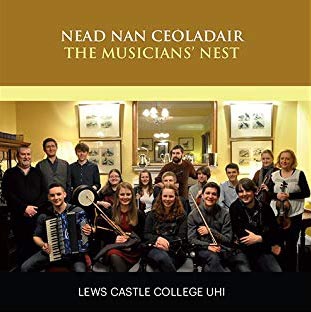Case studies
The Bressay Stone Research Project: Documenting Pictish and Norse Heritage
The Bressay Stone Research Project: Documenting Pictish and Norse Heritage
Background
On the 18th August 2024 John Scott of Bressay contacted Dr Andrew Jennngs. He said that the Bressay History Group had been pushing for the National Museum of Scotland (NMS) to release the early-medieval carved Bressay Stone for a visit to the Shetland Museum in September 2025. NMS said it was willing to agreed to a 3 month period if funding could be found.
John Scott said he and the Bressay History Group wanted to make the best of this opportunity, and to develop a better awareness and understanding of the stone, and the rather scant knowledge of the era of the Picts, in Shetland. He had asked the Shetland Museum to collect all the archaeological artifacts from Bressay and Noss that it had stowed away, so that they could be presented in context when the Stone visited. He had a great desire for Shetlanders to see the stone in its local, historical context.
A series of meetings with the Bressay History Group, Shetland Museum and the Centre for island Creativity were held in Bressay and at the Shetland Museum. There was discussion about how to best display the stone when it arrived, and about organising a conference of experts to coincide with the display.
Dr Jennings was tasked with providing a current, researched overview of the the nature and importance of the stone, to support the display and provide a background for the conference.
This was seen as a great opportunity to fulfil a research request from the community!
As it transpired, funding for the visit of the stone was not forthcoming. However, the Museum will reapply, and the research undertaken will be extremely valuable.
Project overview
Project task:
The Bressay History Group, a registered charity, sought to develop new educational and public engagement resources centred on the Bressay Stone, a significant local monument. However, they required a comprehensive, foundational body of research to underpin these future projects, which include a new permanent exhibition, an audio guide, and an international conference.
UHI Shetland was enlisted for this project due to the specific expertise of its key personnel. The university's role, through Associate Professor in Island Studies, Andrew Jennings, was to apply advanced research skills to gather, collate, and analyse information and data about the stone. The project's academic partner was UHI Shetland, collaborating with the industrial partner, the Bressay History Group. The key skills brought by the university included specialised knowledge in northern and island studies, while the Bressay History Group contributed invaluable in-kind support, including volunteers' time and access to their collection, archives, and local knowledge resources.
Project action and activities:
This project was established as a focused, seven-week period of information gathering and desk-based research, running from January 20th to March 7th, 2025. It was funded by a £2,300 grant from the UHI Knowledge Exchange Sectoral Challenge Fund.
The project's primary deliverable was a comprehensive research report on the Bressay Stone, accompanied by curated archival materials. The role of the academic partner, Andrew Jennings, was to conduct the desk-based and on-site research, while the Bressay History Group's role was to provide access to its resources and local knowledge holders. The collaboration between the two bodies was structured to leverage academic expertise for a community-focused heritage goal.
The research report will also provide the academic bedrock for a conference at Shetland Museum in 2026, that the Bressay History Group will take part in. Jenny Murray from the Shetland Museum said, ‘Wow, thanks for sharing this Andrew – your Fridays ‘off’ have been very well spent! Congratulations - it is a fascinating paper with much to think about. Are you planning to publish it somewhere soon? I would like to cite it in my Shetland chapter when I discuss the conversion of Norse pagans!’
Project outcomes and results:
The project successfully delivered its primary outcome: a comprehensive research report on the Bressay Stone accompanied by curated archival materials, in the form of a relevant bibliography for further research. This report provides a deep analysis of the stone's history, iconography, and linguistic significance, confirming it as a pivotal monument of cultural convergence in 10th-century Shetland. Key findings detail the stone's unique hybrid nature, analysing its blend of Christian symbolism, such as robed clerics and a Jonah motif representing resurrection, with Insular artistic traditions.
Crucially, the research provides an in-depth analysis of the stone's Ogham inscription. This text offers direct evidence of cultural fusion by blending Gaelic words like cros (cross) and meqq (son of) with the Old Norse word dóttir (daughter) and Norse personal names like Naddoðr and Benises.
The primary benefit is that the Bressay History Group now possesses the foundational research documentation to proceed with ambitious public engagement plans that will enhance public understanding of Shetland's Pictish-Norse heritage. These planned next steps include developing an international conference, a new permanent exhibition in the Bressay Heritage Centre, and an island-wide audio guide.
A significant learning point is how the stone's existence challenges simplistic narratives of Viking conquest and cultural eradication. It instead points to a more complex interaction where local traditions were adapted by new communities. The project was a successful model of collaboration, combining the university's research expertise with the charity's invaluable access to local collections and knowledge to create a richer outcome.
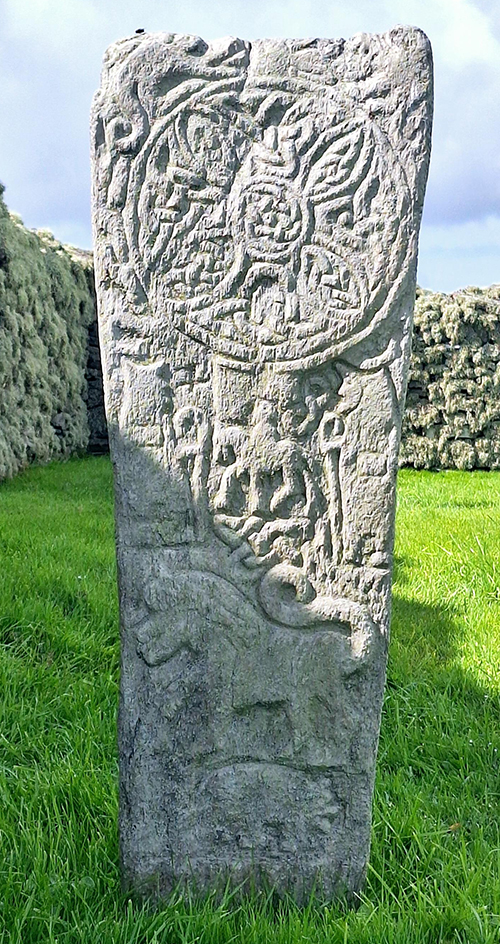
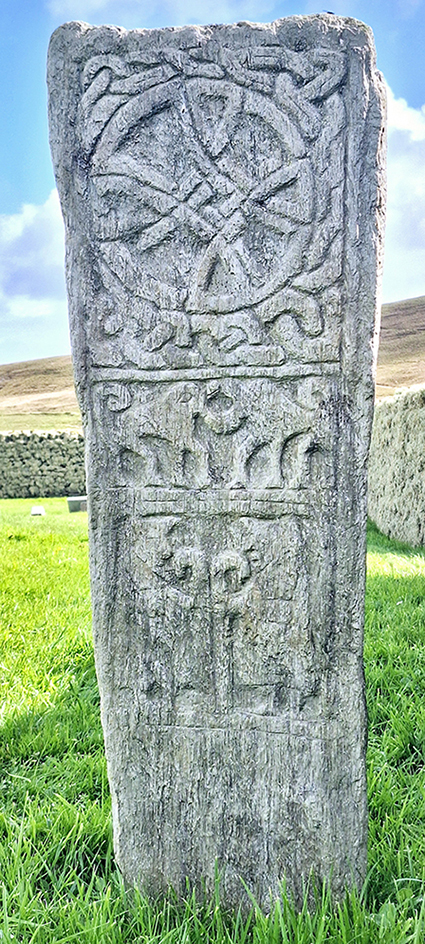
Hynish Trust
Hynish Trust
‘Shining a light on the stories of Hynish’ was a collaboration between the Centre for Recreation and Tourism Research (CRTR) and the Hynish Trust that sought to strengthen the skills and capacity of the trust in the arena of gathering and publishing stories, supporting their ambition to enhance the interpretation offered on site. Over a series of online meetings and a two-day knowledge exchange event at Hynish, Tiree, the partners worked together to publish a series of stories about the site online. These were enhanced by the addition of 360° photographs of key sites. The stories were promoted through social media and online blogs. CRTR supplied the Hynish Trust with detailed guidelines as to how they could replicate this activity, including using the stories to create an audio trail, and a list of suggested funding sources. Another key activity was planning further potential collaborations.
Background
Hynish Shore Station is the only one of its kind in the UK, created to support the building of Skerryvore lighthouse, the tallest lighthouse in Scotland. The Hynish Trust brought the site, comprising multiple buildings and an exhibition, into community ownership last year. They have received funding to improve the site infrastructure and have further ambitious plans to enhance the interpretation offered on site via a renewed exhibition space, and the creation of a self-guided audio trail, video content, and other innovative digital interpretation methods. This project aimed to support these aims by increasing the skills and confidence of trust personnel in gathering and publishing stories, strengthening future funding applications and enhancing their digital presence.
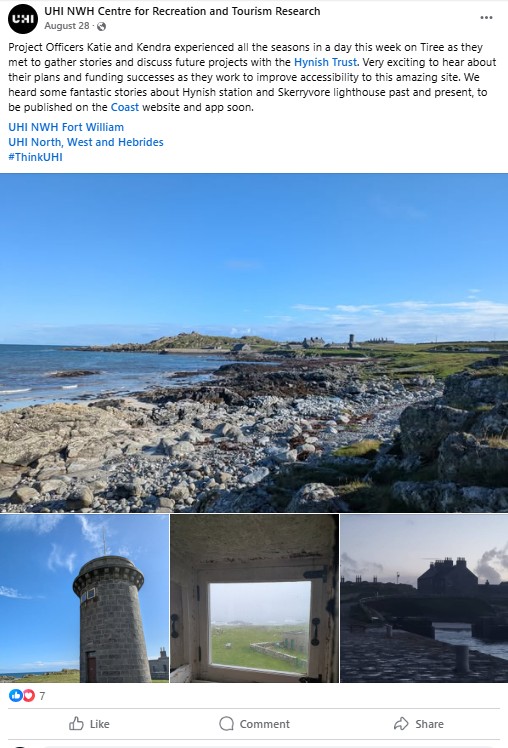
CRTR Facebook post during visit
Project rationale
The impetus for this collaboration was to build the capacity of the Hynish Trust in the area of story gathering and publication, to support their stated ambition of building a self-guided audio trail.
The objectives were:
- Raising awareness of the Hynish Trust amongst local and international audiences.
- Raising awareness of the rich heritage of the Hynish shore station and Skerryvore lighthouse amongst local and international audiences.
- Creating a partnership between UHI North, West & Hebrides and the Hynish Trust with the intention of collaborating further.
- Enhancing the profile of UHI and UHI North, West & Hebrides amongst heritage organisations, providing opportunities for further knowledge exchange and opening the door to possible future collaborations.
The outputs were a series of six new stories about Hynish Shore Station and Skerryvore Lighthouse on ‘The Coast that Shaped the World’ website and app, 360° photographs of key locations around the site, a social media campaign, blog posts, and a set of guidelines about story gathering and publication.
Project activities
The project started with an online meeting between the partners to discuss the project ambitions and strategy. ‘The Coast that Shaped the World’ platform was introduced and a series of goals for the field visit to Tiree was agreed.
CRTR staff then spent 1.5 days at the Hynish site meeting with trust representatives and local story contributors. They agreed on the stories that would be published and collected the relevant geolocation markers and 360° photographs of the site. During this visit they also meet with members of the Hynish Trust to understand their needs and ambitions and discuss potential future collaborations.
Two individuals wrote the stories and supplied illustrative images on behalf of the Hynish Trust. CRTR provided feedback on these and uploaded them to the Coast platform, along with links to some of the 360° photographs hosted on Google Maps. CRTR promoted the new stories via Coast social media. These posts were reshared by the Hynish Trust as well as other local businesses and individuals, leading to more traffic to the Coast website and app. CRTR published a blog on the Coast website and wrote a second one for the Hynish Trust site. CRTR developed story gathering guidelines for the benefit of the trust and carried out a scoping exercise for possible funding to support future collaborations.
CRTR have also drafted and disseminated plans for a future collaboration based around the creation of a community-curated audio trail and other on-site interpretation. Discussions are ongoing.
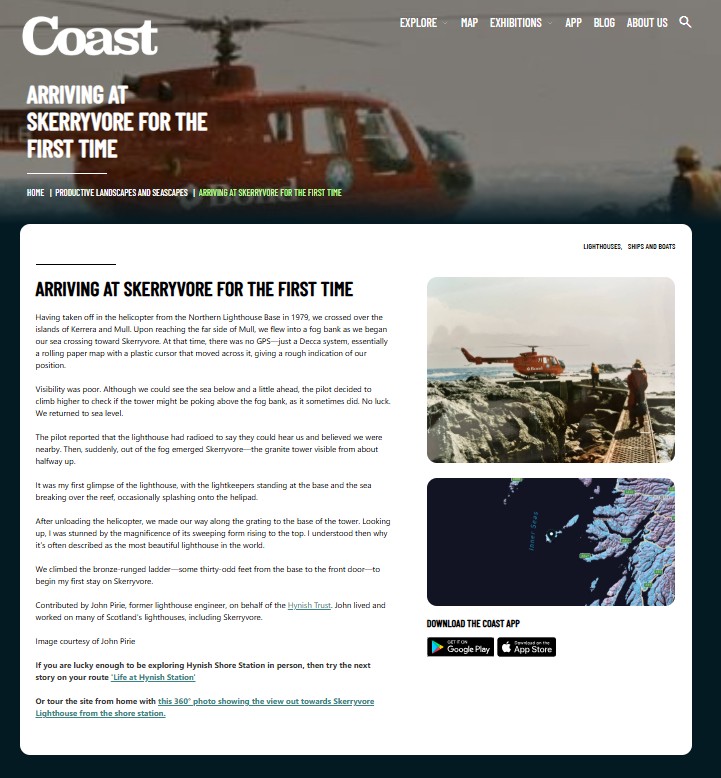
Example story on COAST website
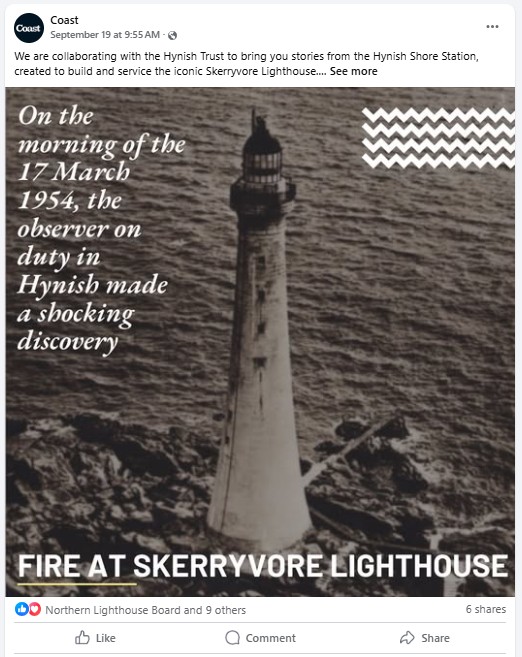
Example story on COAST website
Read the stories:
- Hynish Shore Station: a beacon of maritime heritage - Coast that Shaped the World
- Fire at Skerryvore lighthouse - Coast that Shaped the World
- Arriving at Skerryvore for the first time - Coast that Shaped the World
- Life on Hynish station - Coast that Shaped the World
- Hynish assembly station - Coast that Shaped the World
- A clash of cultures on Tiree - Coast that Shaped the World
They were promoted on the following websites and social media platforms:
“These stories look superb: I love the layout and the images are great. The format is so accessible and visitors will have a wonderful time exploring with these aides. John P and John H's material is so interesting. Thanks again… just a great project to be involved in.”
Lucy Portchmouth, Hynish Trust coordinator
Albastur Cultural Exchange
Albastur Cultural Exchange
Albastur Cultural Exchange is an ongoing research project with the remit to explore and investigate the Scottish and Asturian (Northern Spain) Celtic music traditions and forge strong cultural links between them.
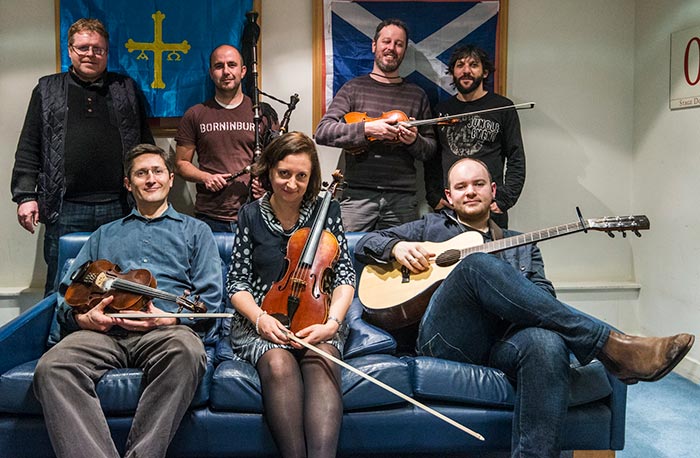
The project is based on field trips involving staff and students from the University of the Highlands and Islands who collaborated with professional practitioners from both locations. This project reports and reflects on the added value that can come from assimilation through immersion and the benefits of international cultural exchange for both staff and student. The positive outcomes from the project have the potential to inspire and install confidence in teaching professionals to embrace students as active researchers and practitioners in line with the Teaching Excellence Framework.
Applied Drama
Applied Drama
Applied drama refers to performance embedded into educational and therapeutic contexts and is of growing relevance as alternative and inclusive approaches to education and health are sought by providers.
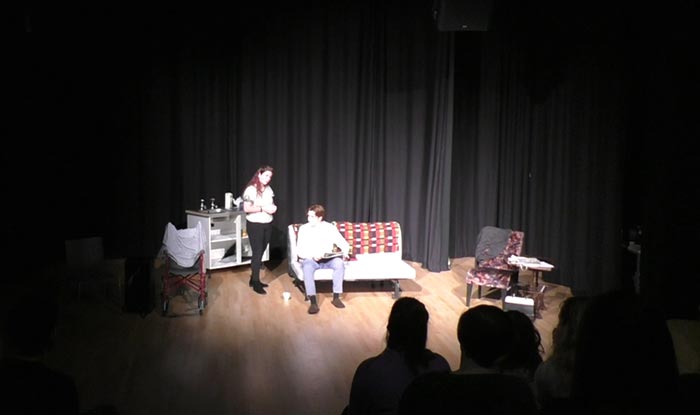
Drama therapy, including role play, is increasingly employed as an alternative to drug based therapy; and drama workshops and performances are highly effective in delivering education across all levels, from primary school to post graduate curricula, and often draws on embodied empathy to enhance understanding of human experience as well as encouraging critical analysis of complex social conditions. In this way, applied drama can be culturally and personally empowering for diverse communities, and offers a collaborative and tailored approach for addressing specific and relevant issues.
UHI Drama is fully committed to the ethical principles and social impact of applied performance and to this end has been working closely with Highland Hospice on a project relating to palliative care. This entailed the performance of Homeward Bound, a play charting the experience of Seth and Lesley Goodburn after Seth’s diagnosis of pancreatic cancer, leading up to Seth’s passing. The play was written by Lesley Goodburn and Brian Daniels and is intended to influence the next generation of policy makers and clinical staff, ensuring that medical procedures are patient focussed, despite ongoing pressure on NHS resources.
Development of the play was embedded into a module on our BA (Hons) Drama and Performance, and was followed by performances facilitated by Siobhan Neylon, an expert in palliative based at Highland Hospice in Inverness. An audience of medical and nursing students was invited, and the play was stopped at critical points to allow Siobhan to explore Seth’s experience through dialogue with the audience; this was with a focus on driving best practice and emphasising the crucial importance of prioritising the individual at the heart of clinical procedures, even when staff are working in extremely stressful circumstances. The performance was so effective in communicating this message through drawing in audience empathy, that it was performed again at an NHS conference in palliative care, which took place in Inverness during March 2019.
The project has attracted attention from educators, public health professionals, as well as performance practitioners and has provided a springboard for a bigger project involving knowledge exchange between these sectors. To this end, Dr Lesley Mickel, programme leader for UHI Drama, is applying to the Royal Society of Edinburgh for a research network grant to support a series of seminars involving Highland Hospice, Hospice UK, palliative care support groups and performance practitioners, among others, to develop a project investigating that ethical responsibilities of developing performance from sensitive documentary evidence, how that evidence may be developed effectively in terms of performance and other outputs, and how these outputs may be best deployed in educational contexts.
Far Flung Corners
Far Flung Corners
The Far Flung Corners project is a partnership with the award winning SoundStorm Music Education Agency and the BA (Hons) Applied Music to devise and deliver workshops in creative music making and song-writing across schools in the UK.
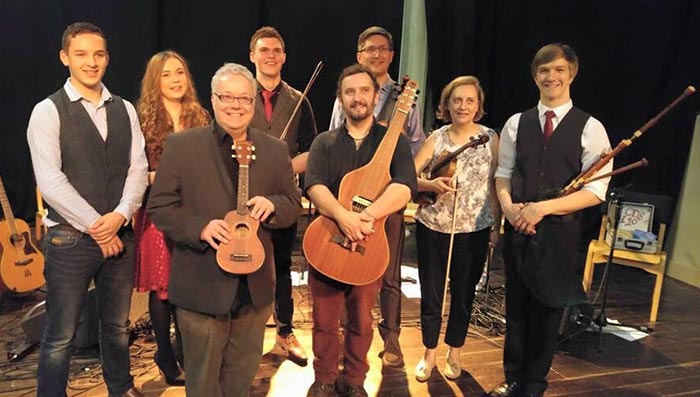
Since 2014, the project has delivered workshops and performed to 4000 young people in schools in Dorset and the Hebrides, providing students with an opportunity to work with professional musicians on a creative musical exchange. The project explores themes of environment in all senses: physical, cultural as well as sustainability, identity and tradition. Far Flung Corners Project was a finalist in the Herald Higher Education Awards 2017 for their community engagement. A highly successful and creative endeavour, in 2017 the project launched a commercial recording at the Celtic Connections Festival and has received excellent reviews and was album of the week on BBC Radio nan Gàidheal.
March 2020 will see the release of the follow up album in Poole’s Lighthouse Theatre. Thank you to Arts Council England and Soundstorm and Wave who are key funders.
Reviews
Orain na Cloinne Bige
Orain na Cloinne Bige
We were commissioned by the Comhairle nan Eilean Siar’s Multimedia Unit to source, arrange and record music for 20 new Gaelic songs for early years, working with young Gaelic singers in the community in Uist.
The songs are accompanied by animations and the app has now been incorporated into Scotland’s Glow Education resources: Singing to Learn, Learning to Sing.
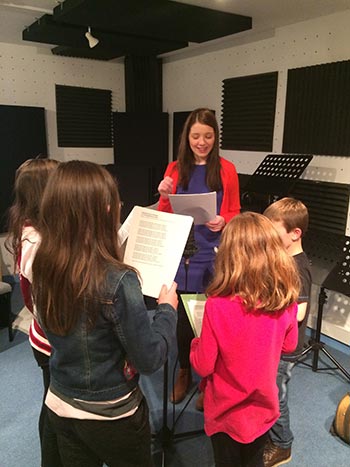
The Musicians' Nest
The Musicians' Nest
The Musicians' Nest - An album showcasing the talented musicians that have immersed themselves in music on the courses in Benbecula and have gone on to win awards and work in the traditional music field.
"A wonderful collection of Gaelic and Scottish Island music, one in which is an absolute credit to Lews Castle College UHI..."
Ian D Hall, Liverpool Sound and Vision
Featuring Manx fiddler Tom Callister, Seonaidh Macintyre with Trail West and Elephant Sessions fiddler Euan Smilie, Inyal’s Robbie Greig, bands Eabhal and Hecla, Breabach piper and flautist James Duncan MacKenzie.
The album was launched with a huge reunion gathering at the Glasgow Royal Concert Hall as part of the Celtic Connections Festival programme February 3rd 2018. The recording has received excellent reviews and was album of the week on BBC Radio nan Gàidheal.
